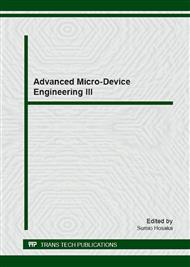p.3
p.7
p.12
p.17
p.22
p.26
p.31
p.36
Effects of Interface Roughness and Lattice Strain on Perpendicular Magnetic Anisotropy in Co/Pd Multilayer
Abstract:
The effects of strain and interface roughness at the Co/Pd interface are investigated from the viewpoint of perpendicular magnetic anisotropy (PMA) using the DV-Xα cluster model calculation method. It is found that spin projected occupation number ratio of magnetic quantum number |m| = 2 for the Co 3d electrons enhances by expanding the lattice within a close-packed plane of fcc stacking and, hence, enhances the PMA. Rough interface decreases the spin projected occupation number ratio of |m| = 2 and, hence, decreases the PMA. These results explain the PMA properties of Co/Pd multilayers fabricated using molecular beam epitaxy (MBE) technique and RF sputtering techniques.
Info:
Periodical:
Pages:
7-11
Citation:
Online since:
January 2013
Price:
Сopyright:
© 2013 Trans Tech Publications Ltd. All Rights Reserved
Share:
Citation:


